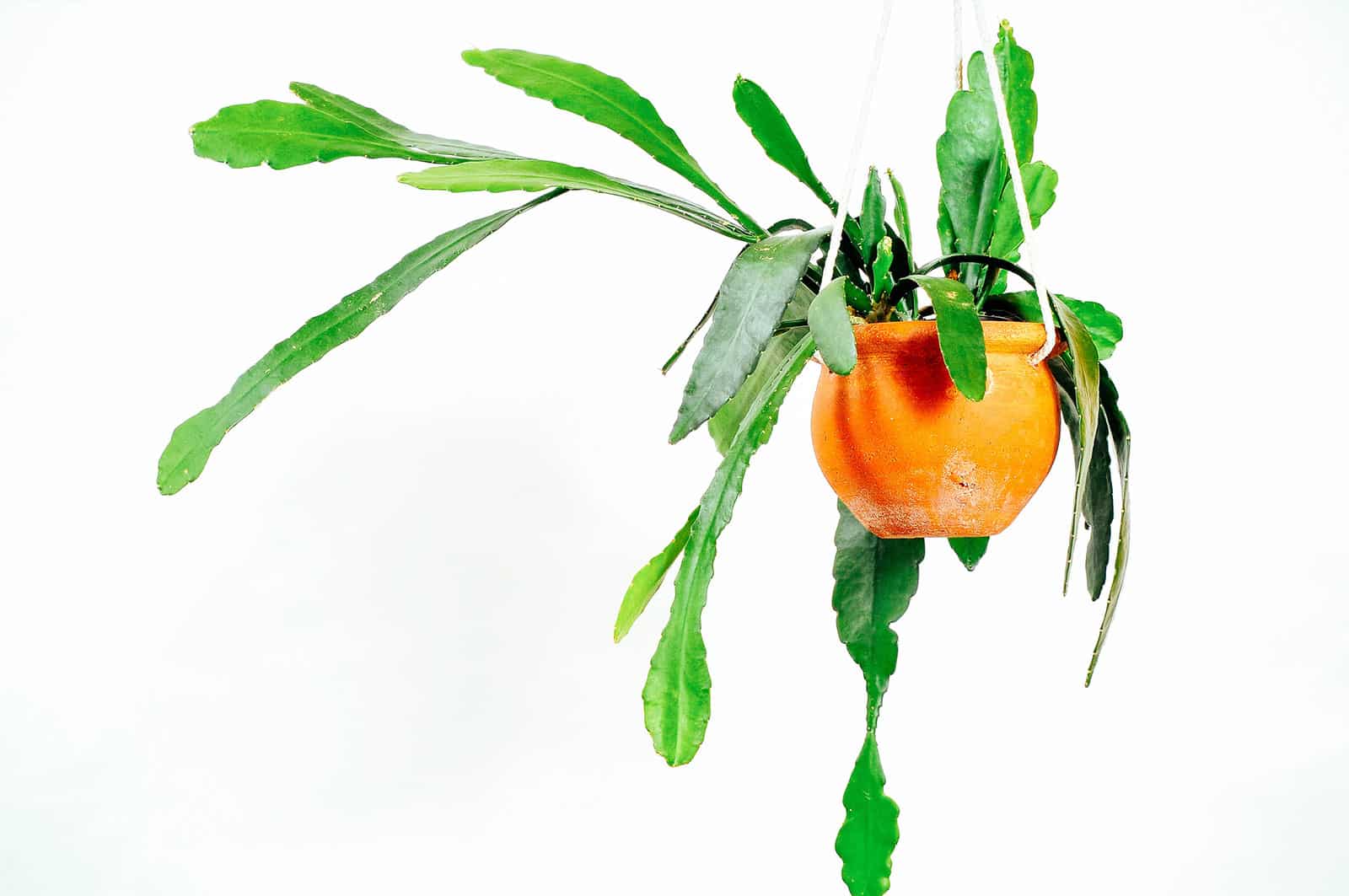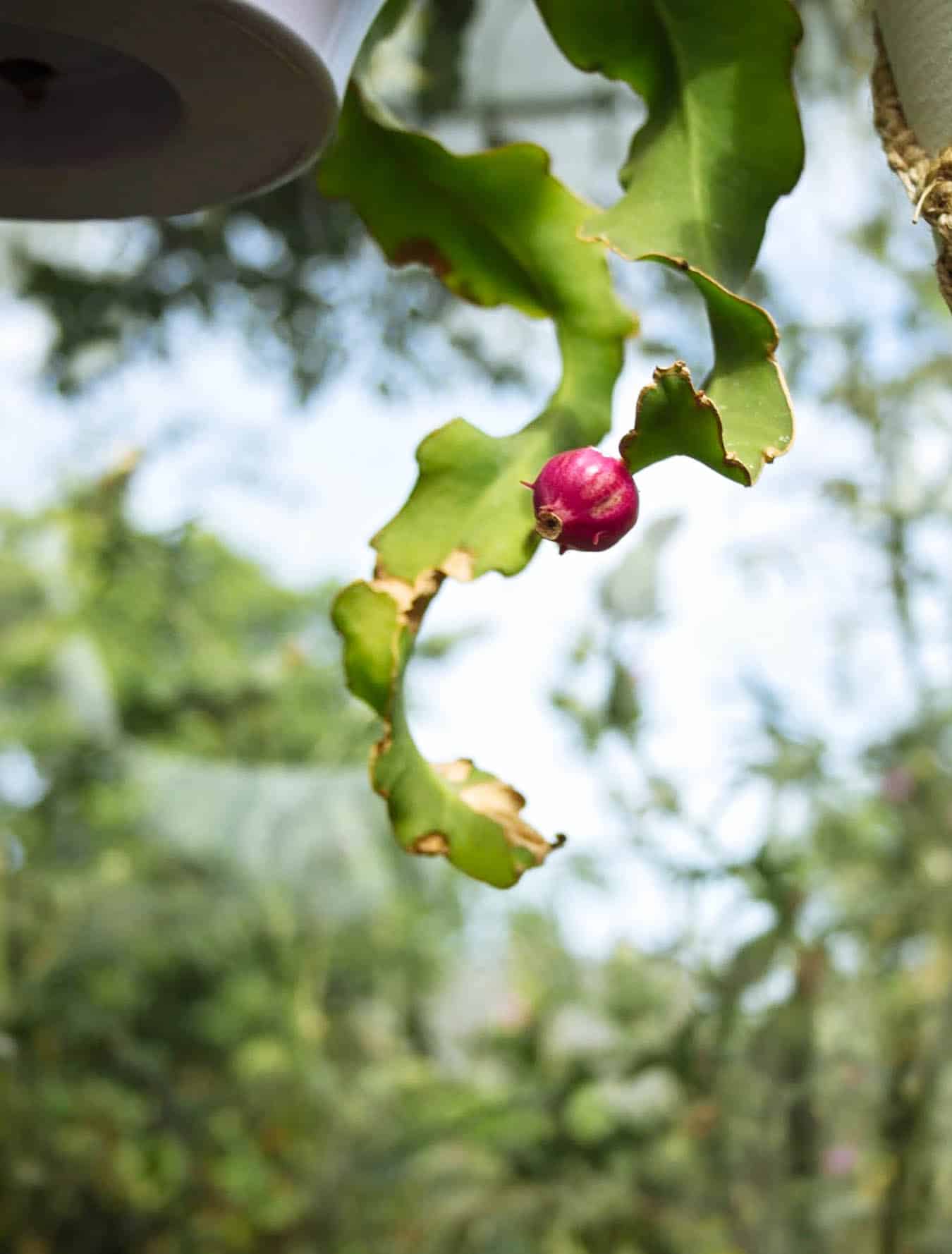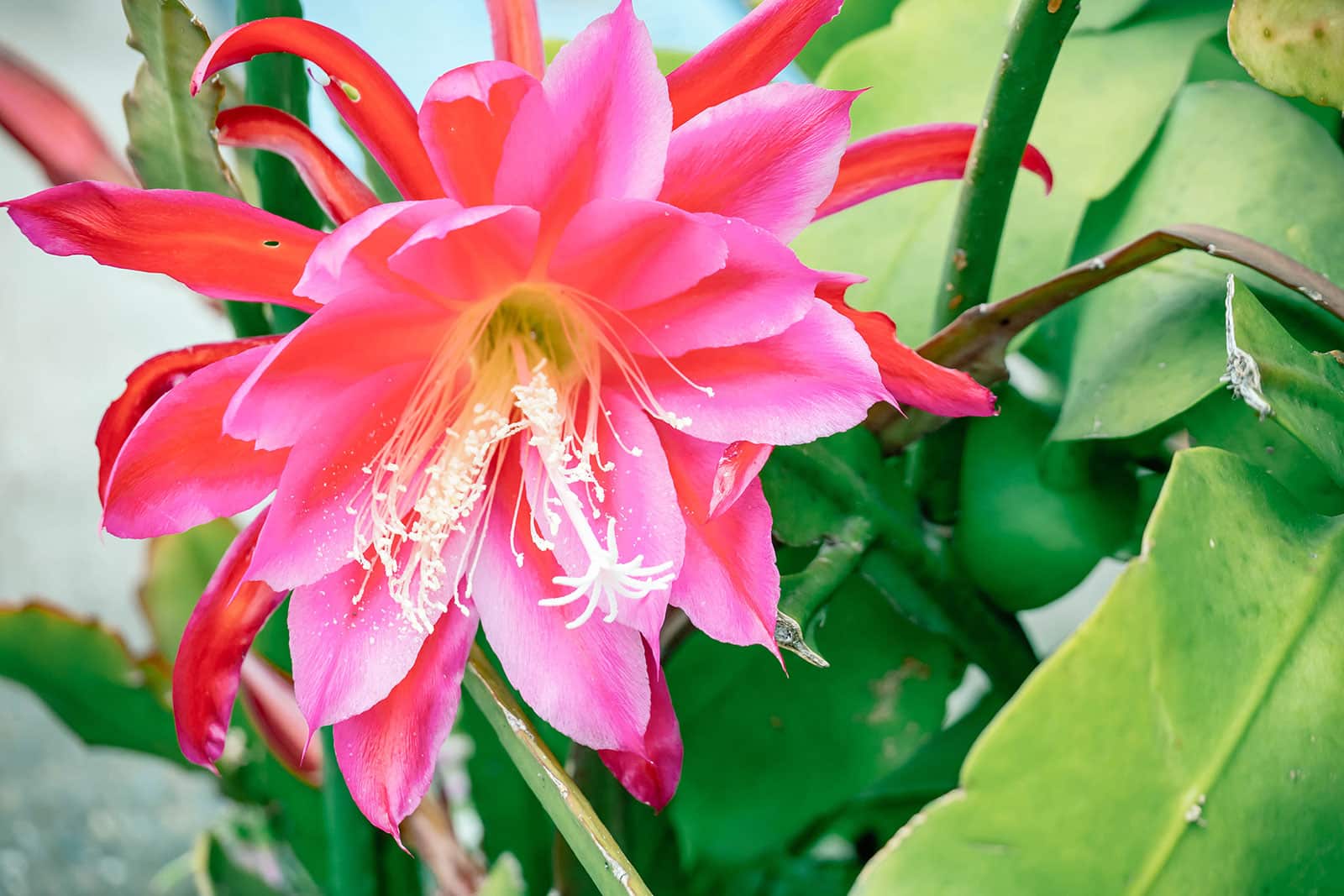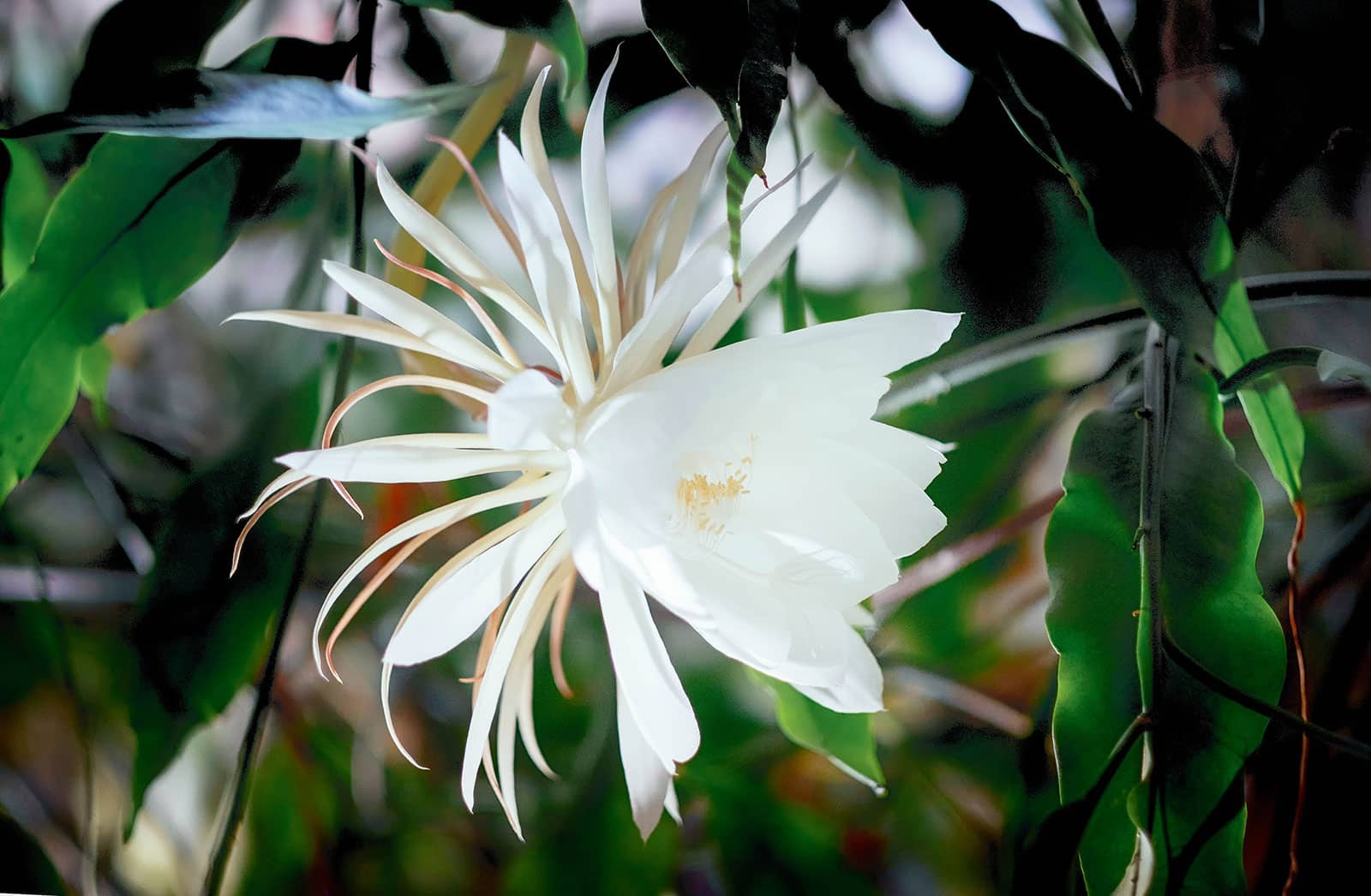Did you know that not all cacti grow in the desert? Today’s subject is an example of a jungle cactus, which are characterized by their flat foliage, lack of spines, and breathtaking flowers.
Meet Epiphyllum, an epiphytic South American native also (quite appropriately) known as the orchid cactus.
The members of this genus are popular in the houseplant hobby and easy enough to grow, but it’s important to remember you can’t treat them like you would a desert cactus.
Here’s everything you need to know about Epiphyllum cactus care and how to make sure yours thrives and even blooms in your home!
| Common name(s) | Orchid cactus, lady of the night, climbing cactus |
| Scientific name | Epiphyllum sp. |
| Family | Cactaceae |
| Height and spread | Up to 8 feet in length and 2 feet wide |
| Light | Bright indirect |
| Soil type | Light and well-draining |
| Water | Keep lightly moist |
Disclosure: If you shop from my article or make a purchase through one of my links, I may receive commissions on some of the products I recommend.

About Epiphyllum
Description
Jungle cacti like the genus Epiphyllum can be recognized by their unusual foliage. Unlike their desert cactus cousins, which tend to be round and plump in order to minimize surface area and conserve water, these jungle dwellers sport segmented fleshy leaves. That explains why they’re also called leaf cacti!
Some jungle cacti are terrestrial (they grow in soil), but many, including Epiphyllum, are epiphytic. This means they naturally grow on trees in a non-parasitic manner, climbing their way up their host’s trunk in search of more light. (Other epiphytic houseplants you might be familiar with include Tillandsias, Hoyas, and Rhipsalis.)
One thing many people don’t realize about cacti is that they’re lavish bloomers, and many species of cactus have beautiful flowers. Jungle cacti are no exception, with the Christmas cactus and Easter cactus being two of the most popular examples.
But sorry, holiday cacti: when it comes to flowers, Epiphyllum takes the cake for me.
Epiphyllum isn’t just called the orchid cactus because (like many orchid species) it’s epiphytic. The name actually refers mostly to the species’ capacity to produce some of the most stunning flowers in the Cactaceae family!
Their blooms are palm-sized, naturally white but sometimes orange, yellow or pink in hybrid varieties, and give off a fantastic fragrance.
Natural habitat
The genus Epiphyllum is naturally found in Central and South America, from as far north as Mexico all the way down to Argentina in some cases. It’s also an introduced genus in a bunch of other places around the world, particularly in China.
As mentioned, in their natural habitat, orchid cacti mostly grow on trees (although some can also be lithophytes, meaning they grow on rocks). It’s not a surprise, then, that they’re mostly found in forested zones. These can vary from tropical to subtropical, mountainous to lowland, and wet to merely moist—as long as there are trees for the cacti to grow on, they’ll thrive.
Epiphyllum’s night-blooming nature, white blooms, and strong fragrance give us good clues as to what their natural pollinators are. Rather than being pollinated by bees, like many plants that open their flowers during the day, the orchid cactus appears to rely on hawkmoths (family Sphingidae) to fertilize its flowers. These moths are noted to have a particular taste for pale-colored flowers and sweet scents.
The IUCN considers most species of Epiphyllum to be of Least Concern. It does note that habitat loss, especially due to agriculture, has definitely affected wild populations.
Uses and cultural significance
The main reason (indoor) gardening enthusiasts love to grow Epiphyllum cacti should be clear by now: few houseplants can beat this species when it comes to flowers. But that’s actually not the only use for these epiphytic cacti!
First off, as a member of the tribe Hylocereeae, Epiphyllum is closely related to the dragonfruit cactus (Selenicereus undatus). Pollinated orchid cactus flowers will produce bright pink fruits that look just like mini dragonfruits when you cut them open. Some of them taste pretty good, others not so much, but they’re all technically edible.

I had the opportunity to try the fruits of the Monstrose cultivar of Epiphyllum hookeri guatemalense myself; they were a little bland but pleasant enough!
Aside from their edible fruit, orchid cacti also feature in traditional medicine in various Asian countries, including Malaysia, Vietnam, China, and India. Their supposed healing properties are said to alleviate a whole range of ailments, from urinary tract infections to coughing and heart issues. They’ve also historically been used in wound healing.

Types of Epiphyllum
The genus Epiphyllum is not a particularly large one. There are currently 10 accepted species. Most of these are grown as houseplants, although some are more common in the hobby than others.
- Epiphyllum oxypetalum: Also known as Dutchman’s pipe or queen of the night, this is undoubtedly the most common orchid cactus. Its flowers, which do indeed open up after sunset, are bright white and absolutely worth losing some sleep for.
- Epiphyllum hookeri: Mostly known for its subspecies, called E. hookeri subsp. guatemalense, specifically a cultivar called ‘Monstrose’ or sometimes ‘Curly Sue’. As the name suggests, it has curly foliage!
- Epiphyllum pumilum: Similar to E. oxypetalum, although its flowers are a bit smaller. They still smell just as divine, though!
- Epiphyllum laui: White flowers with yellowish outer petals.
- Epiphyllum chrysocardium: Maybe the most spectacular of all the Epiphyllums, this one doesn’t just produce the typical huge, fragrant flowers. It also sports unusual jagged foliage, which explains why it’s commonly referred to as the fern cactus.
- Epiphyllum phyllanthus: Smaller flowers, but relatively large, bright pink fruits.
- Epiphyllum baueri: Unusual flat blooms. This one isn’t quite as popular in cultivation as some of its cousins.
- Epiphyllum cartagense: Big, pointy-petaled flowers. Another one of those species that’s not quite as common, meaning it’s mostly reserved for serious collectors.
- Epiphyllum grandilobum: Typical Epiphyllum blooms, but with elegantly lobed leaves.
- Epiphyllum thomasianum: Large white flowers with striking golden stamens.
Where to buy Epiphyllum plants:
Will the real Epiphyllum please stand up?
Like many other popular houseplants, the genus Epiphyllum is a bit of a taxonomic mess. It used to contain a bunch of additional species, but many of these have been determined to belong to other genera, particularly Disocactus.
The most well-known example is the popular Disocactus anguliger, formerly known (and still often referred to as) Epiphyllum anguliger: the zigzag or fishbone cactus.
There’s also D. crenatus (formerly E. crenatum, a parent plant for many of the popular Epiphyllum hybrids), D. ackermannii (formerly E. ackermannii, grown for its beautiful red flowers) and D. phyllantoides (formerly Epiphyllum ‘German Empress’, also commonly used for the creation of new hybrids).
In addition to plants being moved from Epiphyllum to Disocactus, the same thing also sometimes happens the other way around. The cactus now known as Epiphyllum chrysocardium, which we discussed above, belonged to two different genera before ending up where it is now!
With genetic research constantly revealing more information about how plants are related to each other, it remains to be seen how many more species in the Hylocereeae tribe of cacti will eventually end up being moved around and renamed.
Cultivars and hybrids
As with many other houseplant species, selective cultivation and hybridization of Epiphyllum cacti have led to the creation of literally hundreds of different cultivars. All have slightly different flower colors, shapes, and petal numbers, or sometimes unusual foliage.
It has to be said that, thanks to the confusion about Epiphyllum vs. Disocactus, it’s not always certain whether a cultivar or hybrid is even really an Epiphyllum. Different species in the Hylocereeae tribe can be crossed, so it can be a challenge to keep track!
Still, most of these plants should grow fine if you treat them as Epiphyllums.
A few of the most popular Epiphyllum varieties that you may come across at your local plant store include:
- Epiphyllum ‘Clown’: Exquisite! Outer flower petals are a deep fuchsia in color, while the inner parts are white. Parent plant for many other hybrids.
- Epiphyllum ‘King Midas’: Beautiful pinkish peach blooms.
- Epiphyllum ‘Pegasus’: Bright pink flowers, of which the inner petals have lighter edges. I know I say this about every orchid cactus, but this one truly is a stunner.
- Epiphyllum ‘Yellow Tang’: The yellow tang is a tropical reef fish species known for its neon yellow coloration. The flowers on this Epiphyllum definitely nail the color.
- Epiphyllum ‘Agatha’: Gorgeous soft pastel pink flowers.
You can find a more complete list of Epiphyllums over at Epiphyllum.online, including quirkily-named specimens such as ‘Dracula Meets A Virgin’, ‘Beyoncé’, and ‘Yes He Is Gone’.

Caring for Epiphyllum
Light and temperature
Desert cacti are huge sun lovers. Jungle varieties, like the orchid cactus, also like plenty of light.
However, since they naturally occur under the rainforest canopy, where the harshest sun tends to be shaded out by taller trees, they prefer bright indirect lighting.
Indoors, you can place your Epiphyllum next to any window, as it’s unlikely to receive enough sun for it to burn. If you grow yours outside during the summer months or even year-round, though, you’ll have to provide it with a somewhat shaded location.
Epiphyllums like warmth, but it’s important for them to be exposed to cooler temperatures during the winter months as well. This stimulates bud formation, helping to guarantee spectacular blooms during early summer. Just be sure not to let things drop below 50°F, and definitely never expose your orchid cactus to freezing temps.
Water and humidity
If you’d like to grow an Epiphyllum, forget what you know about how much and how often to water a cactus. Unlike their desert cousins, jungle cacti don’t like for their soil to dry out fully. The habitats they naturally occur in can get pretty wet, after all!
It’s best to keep the soil lightly moist. During the summer growing months, you can water once the medium has gone about a third of the way dry. In winter, when your Epiphyllum is likely not actively growing, you can wait a bit longer.
In terms of humidity, these plants aren’t the fussiest. Still, if the air moisture levels in your home regularly fall below 40 percent, it may be a good idea to run a humidifier. Most tropical houseplants appreciate this, not just orchid cacti!
Soil and planting
When choosing a soil mixture for your Epiphyllum, avoid anything too heavy. Pure potting soil isn’t really appropriate for a plant that’s naturally an epiphyte: its roots aren’t used to being buried in a dense medium.
Instead, go for something lighter and well-draining. A mix of 75 percent potting soil and 25 percent perlite or pumice should work well. If the mixture is still not airy enough for your liking, you can even add some fine orchid bark or other gritty material.
When it comes to planting an orchid cactus, as with the majority of houseplants, it’s important to choose a pot that has a drainage hole in the bottom.
Although Epiphyllums naturally climb—and giving yours something like a nice tree branch to grow on would make for a pretty awesome display—most houseplant enthusiasts instead opt for hanging pots. As the plant grows, its leaves will spill over the edges, sometimes growing incredibly long. This results in a pretty dramatic display when it finally blooms.
Recommended products for Epiphyllum care:
- Leaves & Soul Premium Potting Soil for Orchids, Bromeliads, and Epiphytic Plants
- Espoma Organic Potting Mix for Orchids and Bromeliads
- Good Earth Organics Premium Potting Soil
- Perfect Plants Organic Perlite
- Better-Gro Orchid Bark
Fertilizing
Although these cacti are used to growing in relatively nutrient-poor environments, they do benefit from the application of some diluted liquid houseplant fertilizer or specialty cactus food during the growing season. Once a month should do the trick.
Some Epiphyllum growers also swear by a dose of low-nitrogen fertilizer during late winter in order to stimulate blooming. In my experience this isn’t necessary, but you can always give it a try! Just don’t overdo it with the fertilizer while your plant isn’t actively growing.
Recommended fertilizers for Epiphyllum plants:
- Elm Dirt Plant Juice Organic Fertilizer
- The Grow Co. Succulent & Cactus Plant Food
- Cute Farms Cacti, Succulent & Aloe Fertilizer (Liquid Pump Bottle)
Pruning
Pruning an orchid cactus isn’t usually necessary, although sometimes you may want to do so if the leaves become too long and look like they might break.
As you’ll find out in the section on propagation below, any pieces you prune can be used to grow new Epiphyllums.
Dividing or repotting
If your Epiphyllum has outgrown its container but you don’t want to repot it, it is possible to divide it instead. Just take the plant out of its pot and gently untangle the roots.
Different sections will usually come loose by themselves as you do this, but otherwise, you can make a vertical cut through the root ball in order to divide the cactus in as many sections as you’d like.
Pot each section into a separate container with new Epiphyllum soil and voilà! They should keep growing as usual, since they don’t have to expend energy developing a root system.
Prefer repotting instead? Go one pot size up, and don’t forget to give your plant some fresh soil while you’re at it.

Propagating Epiphyllum
Thanks to the way they grow, propagating an Epiphyllum is a breeze. Leaf propagation is the easiest way to multiply this species, and amazingly, you don’t even need an entire leaf. Just a section (minimum of 3 inches) is all it takes!
If you’d like to expand your orchid cactus collection or want to share the love with family and friends, all you’ll need is a pair of sharp, clean scissors and one or multiple small planters filled with light and airy soil.
Snip one or multiple leaves or leaf sections and leave them in a dry place for up to a week so the cut can callous over. Then, just insert the sections into the pots you prepared in such a way that they can’t fall over.
After leaving the cuttings alone for the first few days, you can start watering regularly using a spray bottle. They’ll root in no time!
Once you see new growth appear on the top end of the leaf, you’ll know your propagation attempt has been a success.

Common questions about Epiphyllum care
Is Epiphyllum toxic to cats and dogs?
No, orchid cacti are not considered toxic to cats and dogs, nor to humans. If your furry friend eats a significant portion of your plant, some vomiting or diarrhea is to be expected, but they should be back to their old self soon.
How long do Epiphyllum blooms last?
If you want to see your Epiphyllum in full display, you’ll have to start camping next to the plant at night as soon as the buds look like they might open soon. As mentioned, the blooms open up after dark, and they only last a day or two!
If you missed a flower, don’t worry too much. These cacti usually push out a bunch of blooms throughout the summer months, so you’re likely to get another chance soon.
Sources:
Patel, A., Patel, S., Sanke, P., Potlakayala, S., & Rudrabhatla, S. (2021). Medicinally Important Compounds in the Flowers of Three Higher Plants: Cannabis, Saffron, and Epiphyllum oxypetalum. Biomedical Journal of Scientific & Technical Research, 36(5), 28996-29001.
Prajitha, P., Suresh, A., Deepak, V., & Faslu, H. (2019). A review on epiphyllum oxypetalum (DC.) haw. Asian J Res Chem Pharm Sci, 7(3), 824-30.
Schlumpberger, B. O. (2012). A survey on pollination modes in cacti and a potential key innovation. Evolution of plant-pollinator relationships, 301-321.
















I was given a cutting of the Dutchman’s Pipe in 1995. The parent plant came from over seas. It has only bloomed 2 times. I never seem to have all the right growing conditions for blooming. It is very leggy. I have had to cut it back at least 20 feet . It is way too big for me to handle now and I need to find someone who would take it. I can send pictures if needed. Any suggestions? I live near Branson , Mo.